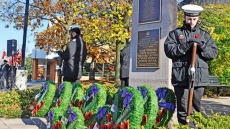Here are some notable cases involving not criminally responsible defence:
Luka Rocco Magnotta
Luka Rocco Magnotta was found guilty of first-degree murder on Tuesday, marking another notable case in which a not criminally responsible defence was not successful. Magnotta was convicted of a total of five charges in the May 2012 death and dismemberment of Chinese exchange student Jun Lin. Magnotta admitted to causing Lin's death, but his defence lawyer argued that Magnotta was not of sound mind during the killing. Experts testified on his behalf that Magnotta is schizophrenic and was psychotic and out of touch with reality the night of the slaying. But prosecutor Louis Bouthillier said in killing Lin, Magnotta kept a promise made several months earlier to take the life of a human being.
___
Christopher Husbands
Husbands was convicted earlier this month of two counts of second-degree murder and other offences in a deadly shooting at a downtown Toronto mall. In reaching their verdict, jurors rejected the defence's contention he should be found not criminally responsible. Husbands admitted to fatally shooting two men and wounding five others after he opened fire in the crowded food court of Toronto's Eaton Centre in June 2012. He pleaded not guilty to multiple charges that included two counts of first-degree murder. His defence lawyers argued Husbands should be found not criminally responsible. A psychiatrist called by the defence testified that Husbands suffered from post traumatic stress disorder and acted like a "robotic automaton" when he found himself confronted at the mall by two men who had viciously attacked him months earlier. The Crown argued that Husbands gunned down the two men in deliberate retaliation for their attack on him.
___
TREVOR KLOSCHINSKY
Trevor Kloschinsky killed Alberta peace officer Rod Lazenby, 62, who had come to his rural property in August 2012 to investigate a dog complaint. He was charged with first-degree murder but Queen's Bench Justice Beth Hughes ruled earlier this month that Kloschinsky, 49, was not criminally responsible. Hughes pointed to a report done by Dr. Sergio Santana, a forensic psychiatrist, who said Kloschinsky suggested to him that it was his right to defend his property against a thief, enforce the law and make a citizen's arrest. "Mr. Kloschinsky's thinking processes were as affected by his delusional thinking as to prevent him from realizing that assaulting officer Lazenby was wrong,'' Hughes quoted from Santana's report. Lazenby was a retired RCMP officer who was responsible for enforcing bylaws in the Municipal District of Foothills. "I do not feel justice has been served for my father, our family member, peace officer Rod Lazenby,'' said Lazenby's daughter, Meghan McLean. McLean said the family is unhappy that Kloschinsky is to be held at a mental hospital and subjected to annual reviews instead of being sentenced to time in prison.
___
GUY TURCOTTE
Guy Turcotte, a cardiologist in Quebec, was found not criminally responsible in 2011 in the 2009 stabbing deaths of his three-year-old daughter and five-year-old son. He was sent to a psychiatric hospital in Montreal and released in December 2012. An appeals court overturned the 2011 verdict in November 2013, and Turcotte is slated to stand trial a second time in September 2015. He is currently free on bail.
___
ALVIN BUCKWOLD
Alvin Buckwold was charged with second-degree murder after his father, Saskatoon lawyer Ian Buckwold, was found dead at the family cottage in July 2013. Alvin Buckwold was found not criminally responsible due to his schizophrenia in June and was remanded to a mental health facility.
___
NERLIN SARMIENTO
Nerlin Sarmiento told court she killed her seven-year-old son by drowning him in the bathtub in February 2013, but argued she was mentally ill at the time. A judge ultimately agreed with the defence arguments, accepting a psychiatric assessment that said the 32-year-old Edmonton woman was in the throes of a serious depressive episode as part of her bipolar disorder. Doctors said Sarmiento believed she was sparing her son from a life of poverty and suffering when she killed him. She was found not criminally responsible in September 2013.
___
RICHARD KACHKAR
Richard Kachkar stole a snowplow in the early morning of Jan. 12, 2011, and in the middle of a two-hour rampage with it he hit and killed Toronto Police Sgt. Ryan Russell. Various witnesses heard him yell about the Taliban, Chinese technology and microchips. Psychiatrists concluded he was psychotic, but struggled with an exact diagnosis. He was found not criminally responsible and was ordered to be held in the secure unit of a mental health hospital near Toronto. The Ontario Review Board stirred controversy, however, by allowing Kachkar to take escorted trips into the community. The Crown unsuccessfully appealed that provision.
___
MILOSLAV KAPSIK
Miloslav Kapsik bludgeoned his wife to death with a hammer, hitting her more than 100 times while they were watching a hockey game in 2010. Court was told he had been hearing voices. Medical records showed the Winnipeg man was first diagnosed with severe depression in 2003. The defence argued he had a mental illness at the time and wasn't criminally responsible, but Kapsik was convicted in March of second-degree murder. He was sentenced to life in prison with no eligibility for parole for 10 years.
___
VINCENT LI
Vincent Li was sitting next to a sleeping Tim McLean aboard a Greyhound bus in Manitoba on July 30, 2008, when he suddenly started stabbing the young carnival worker. As the bus stopped and horrified passengers fled, Li cut up McLean's body and ate parts of it. Li told a mental-health advocate he heard the voice of God telling him McLean was an alien he needed to destroy. Li was found not criminally responsible and was sent to the Selkirk Mental Health Centre. In 2012, he was granted the privilege of escorted trips off the hospital grounds.
___
ALLAN SCHOENBORN
In April 2008, Darcie Clarke returned to her home in Merritt, B.C., to find her two sons and daughter dead. Allan Schoenborn, her ex-husband, had killed their children: 10-year-old Kaitlynne, eight-year-old Max and five-year-old Cordon. He was diagnosed with delusional disorder and said he killed the children to protect them from an imagined threat of sexual abuse. In July 2013, the B.C. criminal justice branch announced Schoenborn would not be transferred from a psychiatric hospital in British Columbia to a pyschiatric hospital in Manitoba, as he had requested. He had asked for the transfer to be closer to his family.
___
GREGORY DESPRES
Gregory Despres killed his elderly neighbours in Minto, N.B., in 2005. He repeatedly stabbed Fred Fulton, 74, and Verna Decarie, 70, and decapitated Fulton. He was arrested in Massachusetts shortly after the bodies were discovered. A naturalized U.S. citizen, Despres had crossed the border the day before despite border guards finding him carrying a small arsenal including a chainsaw, a sword and brass knuckles. He told them he was an assassin on a military mission. Three psychiatrists diagnosed him with paranoid schizophrenia. He was found not criminally responsible in 2008. In May, 2013, a review board said he is still a risk to the public and must remain at a psychiatric facility inside Dorchester Penitentiary.
___
FRANCIS PROULX
Francis Proulx entered the home of Nancy Michaud, an aide to a Quebec cabinet minister, in 2008 and took her hostage while her two children slept. He took credit cards and banking information and shot her in the head. Proulx then had sex with her corpse. During his trial, he argued he was not criminally responsible because of a mental issue, saying he was on medication at the time of the crime. But he was convicted of first-degree murder and sentenced to life in prison with no chance of parole for 25 years. The Supreme Court of Canada refused to hear an appeal.
___
GLEN RACE
Glen Race pleaded guilty to first-degree murder in the death of Trevor Brewster and second-degree murder in the slaying of Paul Michael Knott. According to an agreed statement of facts presented in court in November 2013, Race suffered from schizophrenia and was not taking his medicine in May 2007 when he lured the Halifax men to their deaths in separate incidents. The statement of facts alleged that Race believed he was a vampire slayer and a god-like entity at the time of the killings. Both the Crown and the defence recommended that Race should be found not criminally responsible, and the verdict was officially handed down in January of this year.
___
ELAINE CAMPIONE
Elaine Campione drowned her daughters, Serena, 3, and Sophia, 19 months, in the bathtub in 2006 days before a family court hearing in the midst of a custody battle with her ex-husband. Court heard doctors had diagnosed the Barrie, Ont., woman as having unspecified psychosis with borderline personality traits, post-traumatic stress disorder from spousal abuse, depression and an eating disorder. She had spent time in psychiatric wards, attempted suicide and had delusions that people were trying to kill her and steal the girls. Her lawyer urged the jury to find her not criminally responsible, but the Crown successfully argued her mental illness didn't prevent her from knowing right from wrong. Campione was convicted of first-degree murder and sentenced to life in prison with no parole eligibility for 25 years.





